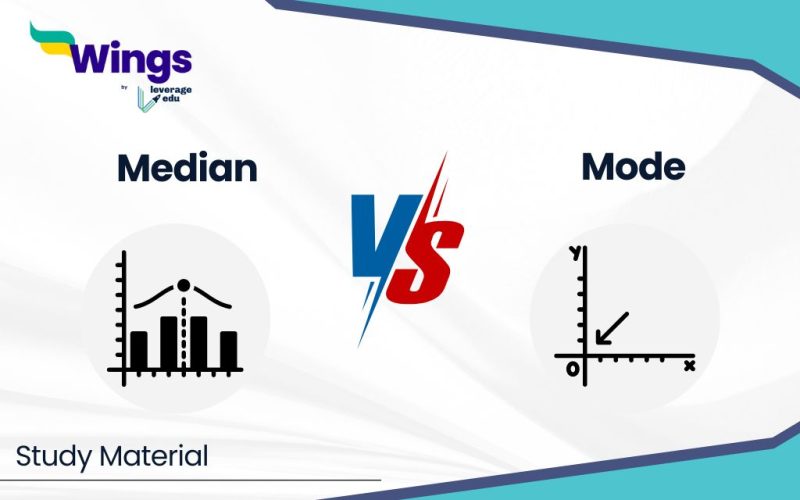The difference between mode and median is that median refers to the midway number when data collection is sorted from least to largest that is in a particular order. While the mode is the number that occurs most often in a data set.
Table of Contents [show]
What is Mode?
Mode, in statistics, is the most frequently occurring value in a dataset. Imagine a set of numbers: {2, 5, 5, 7, 8, 8}. Here, 8 appears twice, making it the mode.
There can be:
- One mode: Most common case.
- Multiple modes (bimodal, trimodal): When two or more values share the highest frequency.
- No mode: If all values appear equally often.
Mode differs from:
- Mean: Average of all values.
- Median: Middle value when data is ordered.
Finding the mode is straightforward for individual data points (ungrouped data). For grouped data (frequency tables), a formula exists to calculate the exact mode value.
What is Median?
Median: the middle value when data is arranged in ascending or descending order.Imagine a line of numbers: {2, 3, 4, 5, 7}. Here, 4 sits in the middle.
Finding the median:
- Order the data: {2, 3, 4, 5, 7}.
- Pick the middle value: 4.
Median vs. Mean (average):
- Median considers the data’s position.
- Mean considers the sum of all values divided by the number of values.
What is the Difference between Mode and Median
The mode is the most frequently occurring value in a dataset, while the median is the middle value when the data is arranged in ascending or descending order. Mode is influenced by the frequency of values, whereas the median is solely determined by the position of values in the data. Below we have provided a list of differences in mode and median:
| Feature | Median | Mode |
| Definition | Middle value in an ordered data set | The most frequently occurring value in a data set |
| Calculation | Arrange data in ascending/descending order, then find the middle value. | Identify the value with the highest frequency. |
| Uniqueness | Always exists (except for sets with even number of values where the median is the average of the two middle numbers). | Can have one mode (most common), multiple modes (bimodal, trimodal), or no mode if all values have equal frequency. |
| Example | Median of {2, 4, 5, 7} is 5. | Always exists (except for sets with an even number of values where the median is the average of the two middle numbers). |
Mode and Median Formulas
The median is the middle point of a data set. To find the median, you list your data points in ascending order and then find the middle number. If there are two numbers in the middle, the median is the average of the two. While the mode is the most common number in a data set. The formula for finding Mode is :
Mode = L + h * ((fm – f1) / (fm – f2))
- L: Lower limit of modal class (class with highest frequency).
- h: Class interval size.
- f1: Frequency of class before the modal class.
- fm: Frequency of the modal class.
- f2: Frequency of the class after the modal class.
Finding the median depends on whether you have an odd or even number of data points:
- Odd number of values: The median is the middle value when the data is arranged in order.
- Even number of values: The median is the average of the two middle values after ordering the data.
Application of Mode and Median in Real Life
Understanding the “typical” and “most frequent” values within data sets is very important in everyday situations. This is where mode and median come into play. For example, in traffic management mode the median plays the following role:
- Mode: Determining the most frequent speed on a road segment (e.g., 50 km/h)
- Median: Representing the average travel time between two locations (less sensitive to outliers) .
RELATED POSTS
FAQ’s
Mode refers to the most frequently occurring value in a dataset, while median represents the middle value when the data is arranged in ascending or descending order.
Mean is the average of a dataset, mode is the most frequent value, and median is the middle value. For example, in the dataset {2, 3, 3, 4, 5}, mean = (2+3+3+4+5)/5 = 3.4, mode = 3, median = 3.
Mode is the most frequent value, median is the middle value, and range is the difference between the maximum and minimum values in a dataset.
The choice depends on the data distribution. Use mean for symmetrical data, median for skewed data, and mode for categorical data with no clear numerical value.
This was all about the “Difference Between Mode and Median”. For more such informative blogs, check out our Study Material Section, you can learn more about us by visiting our Indian exams page.
 One app for all your study abroad needs
One app for all your study abroad needs















 45,000+ students trusted us with their dreams. Take the first step today!
45,000+ students trusted us with their dreams. Take the first step today!
